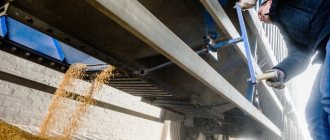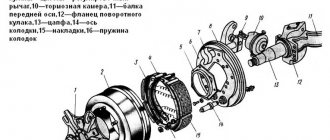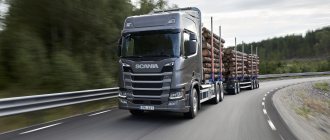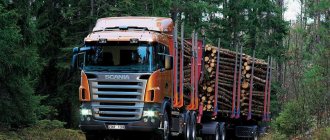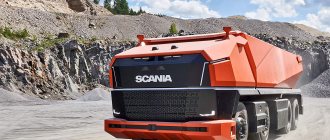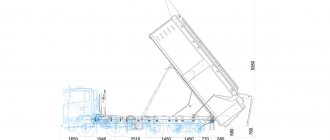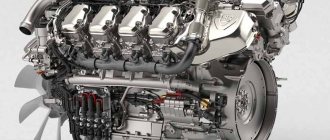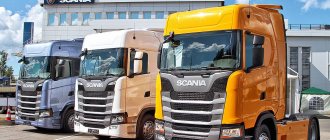Scania grain trucks: springs or pneumatics?
Grain transportation is one of the most profitable types of cargo delivery. In the new season, Scania Rus LLC offers two transport solutions: a flatbed and a dump truck based on the Scania P-Series.
Business philosophy
Russia ranks third in the world in grain transportation after the United States and China. Based on this, the need for specialized trucks is very high. And there are plenty of offers on the market, from domestic complete grain carriers TONAR, NEFAZ and other manufacturers to domestic superstructures on an imported chassis.
A classic grain truck is a road train consisting of a truck and a trailer with a dump body or a bunker made of aluminum or steel. The volume of the body superstructure reaches 20-90 m3, the load capacity is from 17 to 35 tons. The maximum volume of cargo can be transported by tractors with semi-trailers and trucks with trailers. These are the Russian Scania grain transport couplings in the form of cars and trailers with the same superstructures.
The grain truck is most often found in blue, although you can order any other color. The three-axle trailer follows the design of the superstructure, but it also has a front working platform. The “Navigator Credo” trailer uses BPW Eco Plus axles.
Typically, such transport transports grain crops: wheat, rye, barley, buckwheat, peas, oats and some types of feed. Transportation of oilseeds is allowed: flax and sunflower seeds, corn, rapeseed, legumes. But the most profitable type of cargo is sugar beets. This type of transport service is seasonal in nature, which is why it is not as profitable to own such rolling stock as to rent it for the harvest period. Moreover, grain trucks are difficult to adapt to other types of cargo delivery.
The transportation of grain itself is simple and does not require any special additional costs. Suffice it to say that grain does not require a special temperature regime or any specific requirements. True, certain requirements are imposed on the vehicle itself. Its cargo area must be clean, sealed, protected from sunlight, moisture and weathering, and free of foreign odors.
Every whim for your money
The tandem of Scania and “Navigator Credo” represents a trial balloon to study customer demand.
All these requirements are met by grain carriers built by Scania taking into account the requests of Russian carriers. The first wish was a larger cubic capacity (we made 30+30 m3), the same length of the trailer and superstructure on the truck (we made 7200 mm), an onboard and a tipper version (based on the characteristics of unloading). When manufacturing the cars, they did not contact the Scania plant in St. Petersburg, since it is focused on producing dump trucks. Simply put, placing an order for piece goods is not economically profitable. As a result, the chassis was ordered in Sweden, at the main plant in Södertälje. The chassis arrived from there a month and a half later, fully prepared for installation, with brackets. It took another 40 days to build the superstructure.
They chose Naberezhnye Chelny as a partner for the body superstructure; they chose it because the collective farmers know these products well, the pros and cons, and it’s easier for them. In addition, the Chelny manufacturer modernized the trailer, using Austrian side panels for it and the superstructure on the cargo chassis.
The inside of the grain truck body looks exactly like this: with guy wires and chains. The retractable awning rolls onto the left (in the direction of travel) side.
The transverse stiffening ribs were strengthened, the floor was made thicker so that a forklift could enter. Options were added to the basic body: extension sides, rear gates, openable top sides. The list includes things that carriers have so far refused: an electric awning winding device, a double-pitch trailer tire, non-openable top sides, etc. On both models, options increased the cost of equipment in the range from 5 to 10%.
The cars are not made for a specific carrier, but for a warehouse. They will be given to potential buyers for trial use for up to two weeks - to try them on to the specifics of their business. We have these couplings in white and blue in stock, and if the customer prefers something more exclusive, the production time will be approximately 2.5 months. The vehicle chassis is covered by the standard Scania warranty, the superstructure is covered by a 1-year warranty, plus a specialist visit in case of breakdown.
Flatbed 6x2: pneumatics and “extra” two tons
Powerful and reliable front suspension: the axle is designed for a fairly decent load. Underrun protection meets international passive safety standards. The rear air suspension allows you to gain a lifting capacity of 2 tons in one flight. The suspension is structurally complex, but reliable in a Scandinavian way.
Transport assessment
The cost of such transportation was low and cost-effective. It remains so today, because from 70% to 90% of the grain grown by farmers is transported by railroad. The Scania grain truck appeared on the transportation market not so long ago, and its efficiency is appreciated by many farmers. Therefore, over time, trends began to change and farmers see from the experience of past years that prices have changed and additional difficulties have arisen in transporting grown products by rail.
For example, the number of specialized cars has been reduced. Just 10-20 years ago there were about 50 thousand grain cars, then in the early 2000s there were 25 thousand left, and today their nominal number is 15 thousand. Moreover, not all the rolling stock is in good condition.
Scania presented a grain train
Swedish Scania demonstrated its understanding of what a modern grain carrier should be by presenting at the agro-industrial forum “Siberian Field Day 2014” a new agricultural road train with a total body volume of 59.4 cubic meters. m, designed to transport cargo weighing up to 38 tons.
The towing vehicle used is a reinforced Scania P440 chassis with a 6x4 wheel arrangement, equipped with a 440-horsepower Euro-4 turbodiesel. The large wheelbase - 4700 mm - makes the truck more stable when driving and cornering, which is especially important when driving on dirt roads. The three-axle trailer has air suspension and single-pitch tires. When developing the design of the road train, severe operating conditions were taken into account.
The tractor and trailer superstructures were manufactured in Russia (Naberezhnye Chelny). Each is a box-type steel platform with the ability to unload on both sides. Hydraulic equipment - HYVA. The steel sides of the platforms are manufactured by Fuhrmann (Austria). The lower side walls are movable and can be opened with an upper or lower hinge. The middle sides have a top hinge and open only when the lower sides on the bottom hinge are opened. The upper sides are fixed and easily removable. The side locks are mechanical and can be opened manually. The tailgate is made in the form of a swing gate, which makes it possible to load and unload cargo also on Euro pallets. This solution makes the vehicle more versatile, increasing the profitability of the carrier company.
The road train platforms are equipped with a sliding Cramaro awning, which has anti-sagging arches and folds longitudinally towards the front side. This awning is characterized by practicality, light weight, and ease of use. Opening the Cramaro awning system takes only 30 seconds.
In addition to the presented model, the Swedes have developed a number of standard transport solutions for agriculture. Scania is actively developing special vehicles for agricultural work, in particular for transporting grain and sugar beets. The company is actively developing cooperation with all major superstructure manufacturers both in Russia and abroad. The creation and delivery of transport solutions for agriculture necessarily includes an individual approach: the specifics of the transport task and the wishes of carriers are taken into account.
Transportation of grain and bulk cargo
Cargo transportation of grain crops is carried out in bulk (bulk) way. Grain transportation is carried out using specialized equipment (grain trucks), either dump trucks or flatbed trucks.
Transportation of grains is a very responsible and specialized process. Failure to comply with grain cargo transportation standards can lead to serious economic losses. Only by using the services of a professional logistics company can you transport grain in any volume quickly, efficiently and without losses.
Transportation of grain by road
Our company transports grain by prepared road transport. Since the weight of one cubic meter of grain
only within the range of 0.4-0.8 tons, then to reduce the cost of transporting grain, the load capacity coefficient of vehicles is increased by increasing the sides.
As the volume of the dump truck body, flatbed truck, and trailers towed increases, the cost of grain delivery from Ukraine, Russia, and all regions of the Republic of Belarus is significantly reduced.
Alternative to rail
According to Roskomstat, agricultural production is developing. At the beginning of 2000, the country produced three tens of million tons of grain and 7-8 tons of oilseeds, but today grain production has increased by an order of magnitude, and oilseeds by 2-3 times.
Therefore, the railway cannot cope with high-quality transportation due to the number of grain cars suitable for transportation. Another negative trend has increased: the cost of rail transportation. It has also increased.
In this situation, farmers and agricultural transporters have to look in advance for a way out of this unpleasant situation. Today, many of them are turning their attention to the new Scania grain truck. Experience shows that transportation of agricultural products by such a high-quality and modern vehicle with the latest technical solutions, with the right logistics solutions, is comparable to the tariffs of the current railway.
Vehicles for transporting grain
- Tipper grain trucks are specialized road transport. Load capacity up to thirty tons. A big advantage is the high unloading speed, which saves time and does not require additional workers to unload grain.
- Flatbed grain trucks are ordinary trucks that have an open body with extended sides. As a rule, the weight of the transported cargo is no more than 20 tons. It is the most popular vehicle for transporting grain due to its prevalence in the logistics environment. The main disadvantage is that unloading cannot be done automatically, only with the involvement of labor.
- Grain trucks - road trains - the above-mentioned cars with a trailer, truck tractors with a semi-trailer equipped for transporting grain.
- A grain tank is the most secure way to transport grain crops. Perfectly protects cargo from external factors.
These types of cars are available from such brands as KamAZ, Scania, Renault, MAZ, MAN. Similar vehicles are used for the transportation of meal and cake.
Vehicle versatility
Depending on the customer’s requirements, standardized blocks are used and the machine is assembled for immediate needs. The car is adapted to the nominal infrastructure of any farm. For example, some agricultural farms have rather low barns, and the height of the gate is about 3-3.5 m. In this regard, a car with a high height will not be able to get inside. There is another limitation associated with weighing grain products. The cargo along with the vehicle is weighed on platform scales. And they basically have restrictions on the weight and length of the road train. But there are also modern platforms and the task of logisticians is to make the route efficient, bypassing scales that are unsuitable for a road train. This is important and significantly affects the cost of the service.
The unified Scania model overcomes all the difficulties associated with transporting grain; its design flexibility has made it possible to remove almost all restrictions. Therefore, the car today has become popular among customers from the agricultural sector and is capable of completing assigned tasks efficiently, on time and with high quality.
Rules for transporting grain by grain trucks
- Transportation of this type of cargo is not difficult, but certain rules must be followed:
- Transportation in containers with grain moisture content less than 15%.
- Transportation in bulk (bulk) from the fields and with grain moisture content of 15 percent or more.
- Transportation containers are serviceable and marked bags.
- The grain has previously undergone a degassing process.
- The body of the grain truck, as well as the trailer or semi-trailer it tows, is covered with an awning.
Our company has accumulated sufficient experience in the transportation of grain. We offer delivery of grains by specialized vehicles from Russia and Ukraine to Belarus. Our vehicles fully comply with the standards for grain transportation; our drivers are professionally trained. In addition, the entire fleet is equipped with satellite navigation - you will always know where your cargo is.
Grain trucks and other Scania trucks for the agricultural segment
At the Agro 2014 exhibition, which will take place from June 4 to 7, 2014 on the territory of the Expocenter of Ukraine in Kyiv, a Scania 6x4 grain truck with a Wielton trailer and new bodies, as well as a Scania P250 milk tanker, will be presented. New packaging options and additional services can improve the profitability and efficiency of agricultural transportation.
The configuration of the Scania P400 6×4 Euro 4 grain truck with a Wielton trailer and new body models was developed in close cooperation with customers from the agricultural segment. It takes into account the basic requirements of farmers for grain transportation:
• The dimensions of the road train provide unimpeded access to loading and unloading sites, as well as weighing complexes. • The versatility of the bodies allows transportation of various types of agricultural products depending on the season (grains, beets, corn, straw, etc.). • The 6x4 chassis wheel formula and the “Off-road” package allow the road train to be used both on the “field-elevator” and “elevator-port” routes. • Scania Opticruz automatic gear shift system ensures economical fuel consumption regardless of the driver’s experience and qualifications. • New free remote diagnostic service minimizes downtime. • The Scania FMS GPS fleet management system monitors operating costs, including fuel, and also includes many other useful functions. The necessary equipment and the Monitoring subscription package are included as standard.
“The modular principle of production of Scania trucks allows us to assemble any model of road train, maximally adapted to the assigned transport task,” says Andrey Dallakyan, commercial director of Scania Ukraine LLC. – We have extensive experience working with manufacturers of bodies and trailer equipment, both domestic and foreign, so we offer ready-made solutions taking into account individual requirements at various price levels.
The service network throughout Ukraine allows us to keep equipment in constant motion, which is very important during harvesting and transporting crops. The versatility of the bodies ensures their effective use at any time of the year.”
History of the creation of Scania
This car model has been operating in the country for 20 years, specializing in grain transportation. At first, trucks were used mainly for international transport.
Today, 75-80% of Scania cars drive exclusively on domestic roads, and work to serve the agricultural segment. Therefore, by understanding this market and its needs, the car is up to date. The decision to produce grain trucks became an urgent market need. The Scania grain truck today is a vehicle that meets the grain transportation market with the most successful technical solutions. The manufacturer of Skani took into account all the requirements of the agricultural sector and now the car is economically profitable, burns less fuel, so the services of such a carrier are really in demand.
